Bike Brooklyn! is a zine that touches on everything I wish I knew when I started biking in Brooklyn. A lot of this information can be found in other resources, but I wanted to collect it in one place.
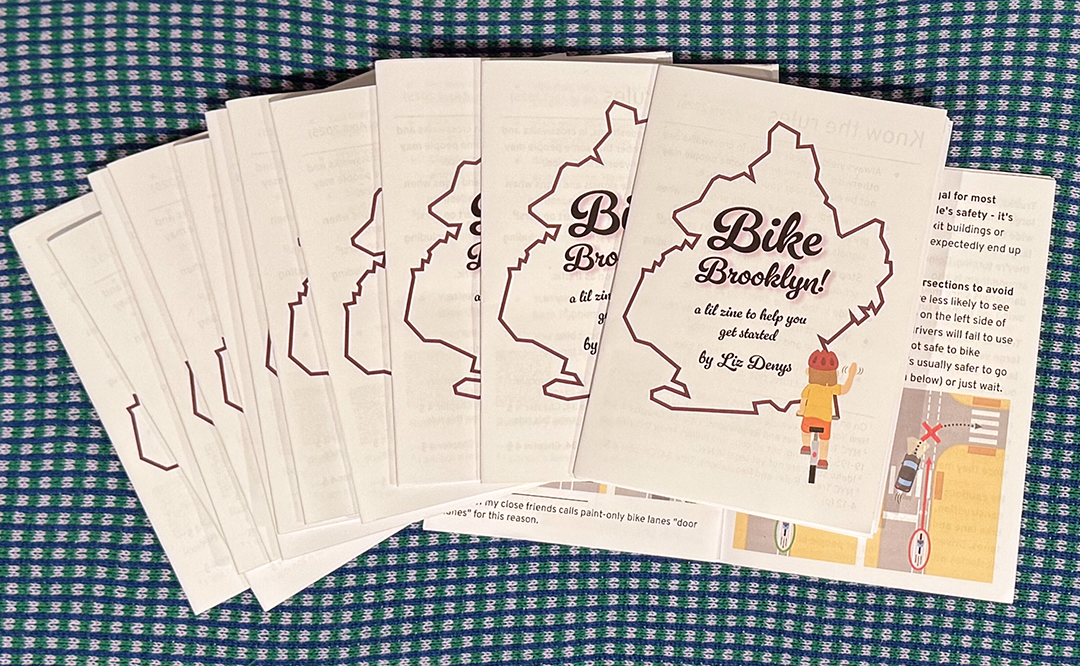
All text and illustrations in the zine are my own. Thank you to Matt Denys, Geoffrey Thomas, Alex Morano, Saskia Haegens, Vishnu Reddy, Ben Turndorf, Thomas Nayem-Huzij, and Ryan Christman for suggestions for content and help with proofreading.
Anything out of date? Suggestions for additional content to include? Email me at bikebk@lizdenys.com.
License
This zine is licensed under the Creative Commons Attribution-NonCommercial-NoDerivatives 4.0 International License. You may print, copy, and distribute this zine for noncommercial purposes in its unadapted form that maintains credit to me. Bike shops, book shops, restaurants, coffee shops, and other commercial establishments are welcome to give out these zines, too - as long as the zine itself is free!
Download Bike Brooklyn!
- A5 size with 2-up spreads for reading digitally
- A5 size with 2-up spreads for printing double-sided on the short edge to be folded down the middle; depending on your printer, you might find some of these subsets of the pages in this version make it easier for you to print:
Below is the web version of the zine:
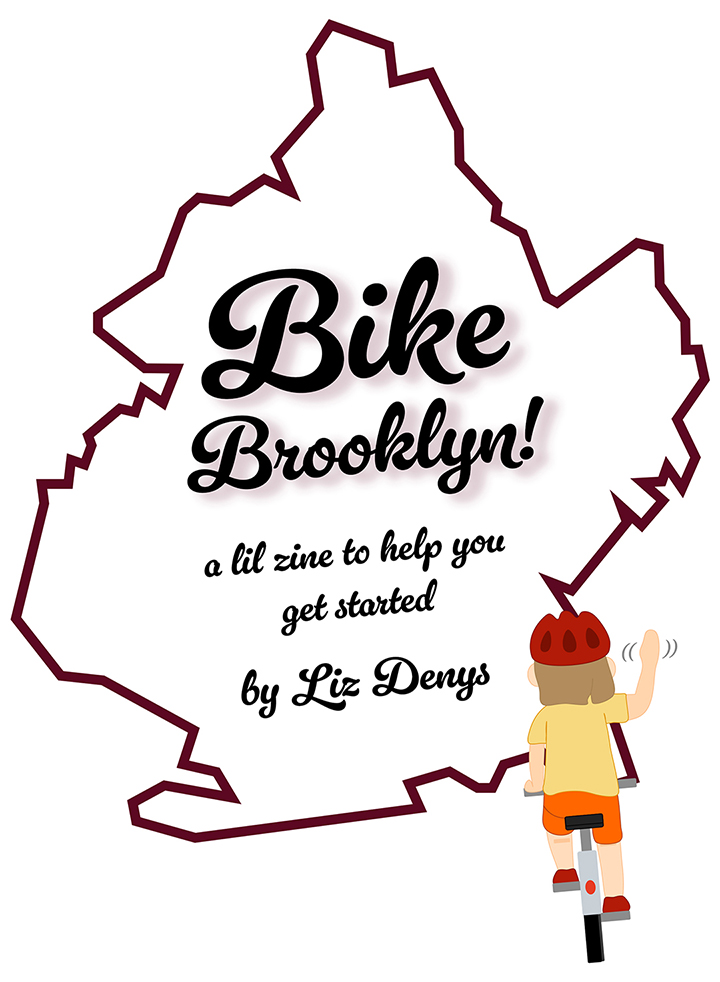
This zine was last updated on October 20, 2025. While I hope to keep this zine up-to-date over time, it's important to note that this release reflects a specific snapshot in time of bicycling in Brooklyn.
Know the rules (as of October 2025)
- Always yield to pedestrians, in crosswalks and otherwise.1 Remember that some people may not be able to hear your bell or voice.
- Follow dedicated bike signals and signs when present; otherwise, follow the pedestrian signals. Often, you get a headstart on cars!2
- Stop at all red lights and stop signs (including school bus stop signs).3
- Ride in the same direction as traffic.
- You must use bike lanes when they're available and you're not turning.4
- On a multi-lane street without bike infrastructure, ride in the right lane.
- You may ride on either side of a narrow, single-lane one-way street.
- Walk your bike when you're on the sidewalk (unless you're under 13).
- Signal when you're turning, slowing down, and stopping. Here's how (view from behind):
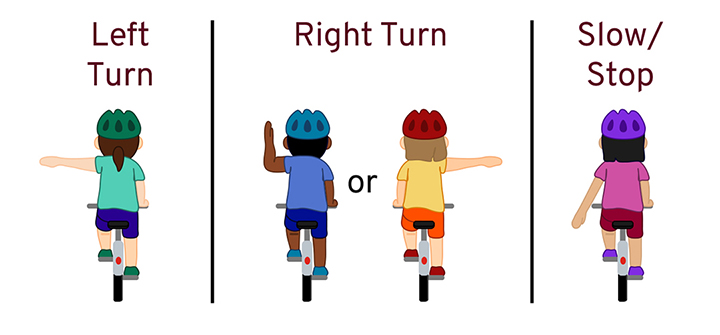
- You must have a white front light and red back light on your bike when it's dark out.
- You're required to have a bell on your bicycle.
NYC DOT's summary of bike rules: https://www.nyc.gov/html/dot/downloads/pdf/bicyclerules-english.pdf
Rules vary outside of NYC. IANAL.5
Ride respectfully
- Keep a safe distance between you and the person biking in front of you. Practice stopping suddenly in a safe place like a park to know how much distance you need to stop.
- Always make sure you have ample space to pass before you start, especially on really narrow two-way paths like the East River bridge crossings. Call out "on your left/right" to let other bicyclists know you're passing.
- You may need to go slower than you'd naturally ride to safely share bike lanes with other riders. This is especially likely if you're riding an e-bike. Don't put pressure on others to speed up by riding too close behind them.
- Look up alternate routes instead of going the wrong way on one way streets or riding on the sidewalk - there's usually one just a block over. You can always walk your bike a block instead, too!
- Expect to go slower when you're on shared paths, i.e. spaces shared by pedestrians and bicyclists, like the 20th St bike boulevard along Green-Wood Cemetery. Make sure to always give pedestrians plenty of space.
- Not everyone knows you can legally bike on Leading Pedestrian Intervals, i.e. when the walk sign says "walk" before the light turns green. Be patient and let them know!
- People walking in touristy places will often be in the wrong spot. This is especially common at the entrances to the Brooklyn Bridge and throughout Brooklyn Bridge Park. Plan to go slowly, use your bell and voice kindly, and remember that not everyone can hear so you always need to be ready to stop.
- If there's nowhere safe to stop other than in a crosswalk, make room for people crossing, including ones with wheelchairs and strollers.
- Point out potholes and other obstacles when anyone's biking behind you! Also, file potholes and unsafe road conditions via 311.
Plan your route
Unfortunately, we still have a long way to go before it's safe and comfortable to ride a bicycle on every street in New York City.6 In the meantime, you should plan to adjust routing to prioritize streets with safer bicycling infrastructure where possible.
Online mapping tools incorporate bike lanes into their bike routing, but I haven't found one that consistently picks safe routes or prioritizes different types of bike infrastructure the same way I do. I always cross reference routes against NYC DOT's official bike map.7
NYC DOT's Bicycle Maps: https://www.nyc.gov/html/dot/html/bicyclists/bikemaps.shtml
NYC bike infrastructure

Protected bike lanes are physically separated from moving cars and trucks, often by a lane of parked cars, a curb, or Jersey barriers. Some intersections lack safe entry points, like Prospect Park West at 10th St, so take note of access points.8
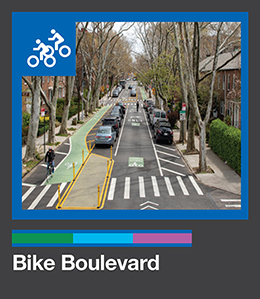
Bike boulevards are streets designed for low car and truck traffic and feature a range of safety treatments to make bicycling safer and more comfortable. These designs are still evolving, so some are more comfortable to ride on.
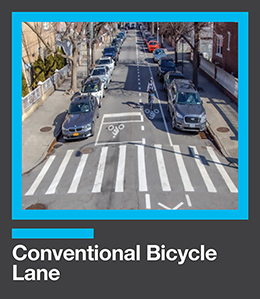
"Conventional" or painted bike lanes, or as I like to call them "paint-only bike lanes," only give you a dedicated space next to moving cars and trucks. Be on the lookout for cars swerving into the bike lane, especially when they might turn. Watch out for cars pulling out of the parking lane and people in parked cars opening doors into the bike lane. Unfortunately, little is currently being done to prevent drivers from stopping and parking in these bike lanes.
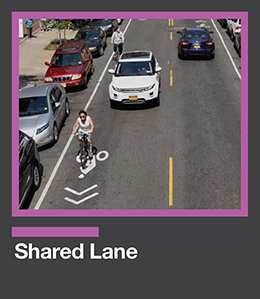
Shared lanes, a.k.a. "sharrows," are just normal vehicle travel lanes with painted bike stamps9, ostensibly to tell drivers to expect bikes. Despite photos and diagrams often showing bicyclists riding next to cars, there is rarely enough space to do this safely in sharrows, and you should always position yourself with safety in mind. Usually, this involves "taking the lane" - it's safer to be in the center of the lane in front of a car so drivers are less tempted to pass you where there isn't enough space. Streets with sharrows aren't necessarily safer than quieter small streets nearby.10

Signed routes just mean you'll be on a regular shmegular street designed for cars and trucks, but signs have been slapped up in a few places to tell drivers to expect bikes.
The bike map also notes cobblestone streets11 - I recommend avoiding these as they're very bumpy! They're common in Dumbo and Red Hook.
How to get comfortable riding in the city
Make sure you have a bike that fits you well,12 is comfortable to ride, and is in good working order. If you're getting back into bicycling after a few years, get a tune up before you ride that bike again.
I found it helpful to get comfortable riding my bike in places without cars before riding on city streets. Some places in Brooklyn to bike without cars:
- Prospect Park
- Brooklyn Bridge Park
- Shirley Chisholm State Park
- Coney Island Boardwalk (Hours vary based on the season, and there will be more space for bicycling on less busy beach days.)
- The Brooklyn Waterfront Greenway, especially the southern section from Bay Road to Bay 53 St and the Jamaica Bay Greenway
- Governors Island13
Some tips to ease into bicycling in an urban environment:
- Give yourself more time than you think you need.
- Start with short trips close to home on roads you are already familiar with.
- Take bike share to somewhere that's easy to get home from on public transit so you don't have to bike back (or have to carry your bike up and down subway stairs).
- Pace yourself on hills; it's normal to be slow. Getting used to hills without cars, like in Prospect Park, can help you gain confidence for hills in traffic and narrow bridge paths.
- Bike with more experienced friends or join group rides - how I got started biking again!
In my experience, biking in the city got a lot easier over my first few months of doing it!
Brooklyn bike wisdom
- You can bring your bicycle on the subway, but not on most buses. You can bring a folding bike on local buses, but not express buses.14
- You may bring your bike on the ferry, but only 8 to 10 full-sized bikes can fit on each boat. You can always bring a folding bike.15
- Bikes are "accommodated on a first-come, first-served basis" on Metro-North16 and the LIRR.17 Folding bikes are always welcome.
- On NJTransit, check for bike icons in the rail timetables. Folding bikes can go on any train.18
- In the Prospect Park drive loop, faster bike traffic and city vehicles on official business are supposed to stay to the right.19 Faster bicyclists also generally pass on the right here.
- Expect to walk your bike through the Grand Army Plaza entrance to Prospect Park on Saturdays during the farmer's market.20
- Not every vehicle that manufacturers call an "e-bike" is legally an e-bike in NYC...
NYC DOT on e-bikes, mopeds, and more: https://www.nyc.gov/html/dot/html/bicyclists/ebikes.shtml
Pedestrian-style turns
Vehicular-style turns, especially left turns across many lanes of traffic, can often be difficult while you're biking in traffic, and pedestrian-style turns provide a safer alternative.
Pedestrian-style turns also help to keep small groups of bicyclists together.
The following example illustrates how to make a pedestrian-style left. Right turns are analogous.
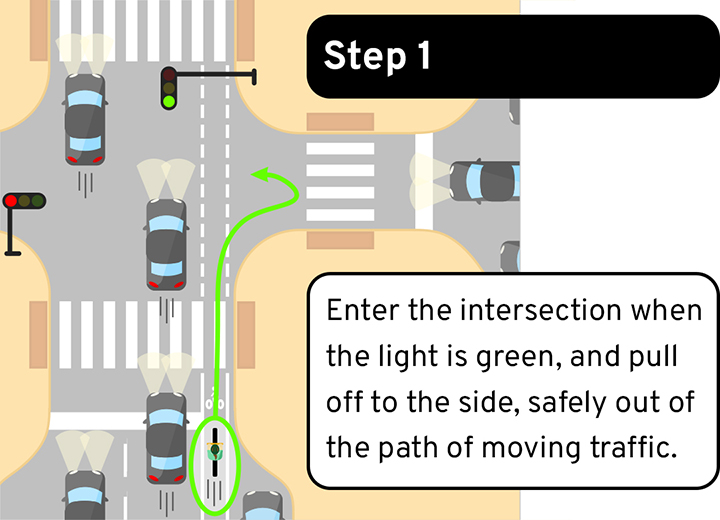
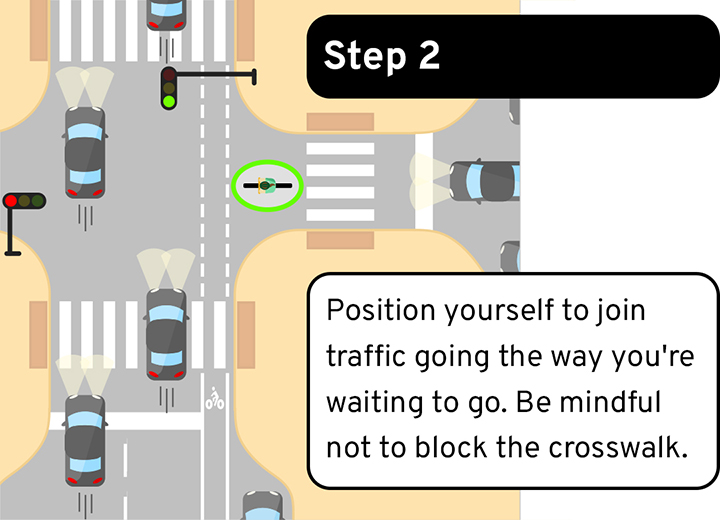
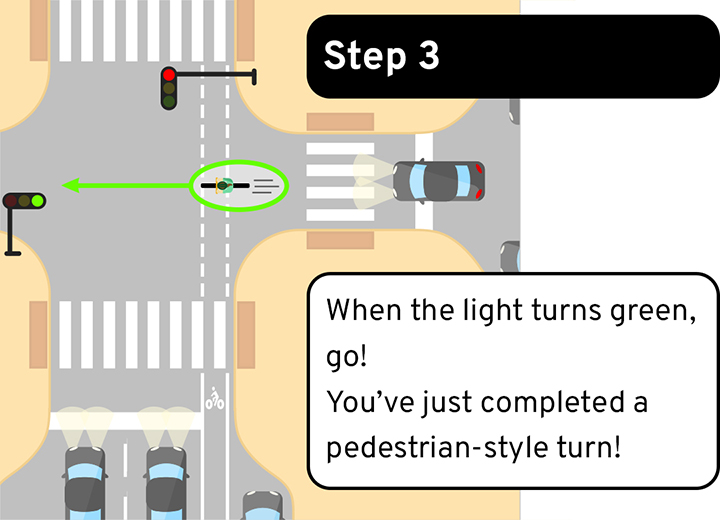
Avoiding collisions
Be predictable. Bike in a straight line whenever you can. Ride in the center of the lane when you take the lane. Use hand signals when turning, switching lanes, slowing, and stopping. Look, signal, and look again.
Stay out of the "door zone." Ride at least 3 feet away from parked and stopped cars so you don't get hit if someone opens their door suddenly. Be mindful that paint-only bike lanes put you in the door zone.21 This danger exists in parking-protected lanes, too - especially in painted buffers.
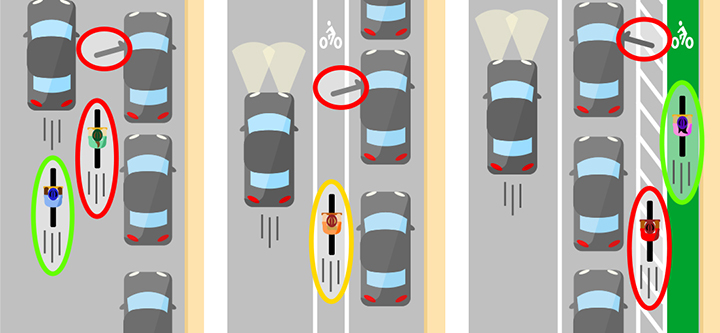
Riding on sidewalks isn't just illegal for most people for the sake of other people's safety - it's also for your safety. People can exit buildings or open doors on parked cars and unexpectedly end up in your path at any time.
Look out for turning cars at intersections to avoid left and right "hooks." Drivers are less likely to see you when turning right as they're on the left side of their car. Remember that some drivers will fail to use turn signals before turning. It's not safe to bike through the path of their turn. It's usually safer to go behind and around them (shown below) or just wait.
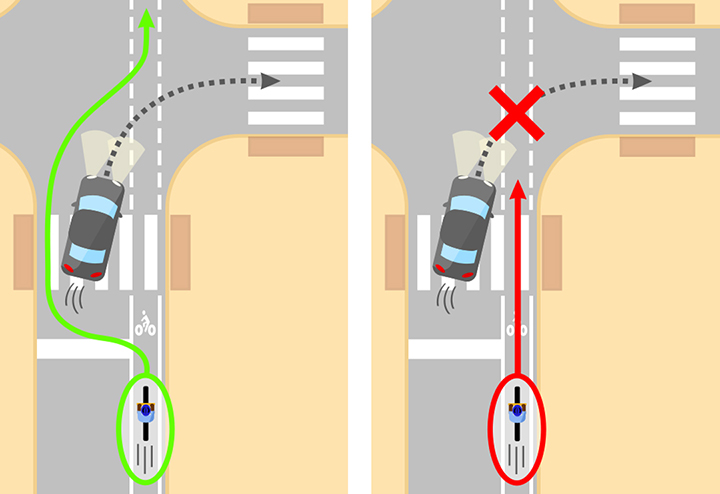
Trucks, buses, and other large vehicles make very wide turns. Stay behind large vehicles when they're turning. Going around them is also dangerous since they swing out to make turns.
Trucks, buses, and other large vehicles also have large blind spots. Stay out of them and don't squeeze beside them and risk getting sideswiped - especially when you're close to intersections since they may turn.
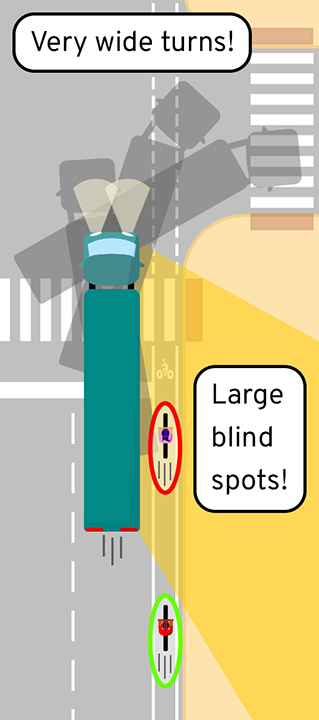
Be cautious when passing double parked cars, construction, or other obstacles, even if you're in a bike lane and they're only blocking car travel lanes. Drivers often assume they can swerve around obstacles without checking for people biking first.
On narrow, one-way streets where you're allowed to bike on either side, it's safer to bike on the left. Being on the driver's side makes it easier for drivers to see you and know where you are relative to them.
Unfortunately, a lot of drivers don't hear or just ignore bike bells. If someone's about to crash into you, scream as well as bell.
While it's annoying when a driver honks at you for no reason, it's actually good - it means they see you!
Get in a crash?
Get out of further danger if you can move, and make yourself visible if you can't. If you're hurt, get medical attention or someone to call an ambulance for you.
Call 911 to report the crash - getting your crash on the record helps with claims later. Try to get contact information from any witnesses, if you can. Stay at the scene if you're responsible for the crash.22
Lock your bike securely!
Use a U-lock or heavy chain to lock up your bike. Combo locks are easy to break; multiple locks make it harder to steal your bike. I use one strong U-lock through my bike's frame and rear wheel when I lock up for a few hours, as shown below.

Always make sure your lock goes through your bicycle's frame, not just a wheel. Make sure you're locking to something that someone can't just lift your bike up off what you've locked to.
Lock up "quick-release" wheels, saddles, and parts. Consider switching to more secure attachments.
Try not to store your bike outside overnight or for a very long period of time, even if it's locked up. This also keeps it safe from the elements, reducing wear.
Don't lock your bicycle to trees, subway railings, or scaffolding. Don't block doors or sidewalk passage.
Can't find a secure bike hoop? DOT has a map!
NYC DOT's Bike Parking Info & Map: https://www.nyc.gov/html/dot/html/bicyclists/bicycleparking.shtml
Office buildings often have secure, indoor bike parking you can use when you're at work. You can put in a request for your office building via DOT.
NYC DOT's Bikes in Buildings: https://www.nyc.gov/html/dot/html/bicyclists/bikesinbuildings.shtml
You should just be able to bring folding bikes into most places, but you might have to fold your bike to do so. If someone's giving you a hard time about it, try putting your folded up bicycle in a large bag.
Flat tires =(
One of the really convenient things about biking in a city is that when you get a flat, you can often walk your bike to a bike shop to get it fixed!
That said, if you get a flat in the middle of the Jamaica Bay Greenway, you might have to walk your bike a long way to get to the subway, and if you get a flat at night, bike shops probably won't be open. If you bike a lot at night or far from the denser parts of the city, you'll probably want to start fixing your own flats. You'll need:
- patch kits or spare tubes23
- tire levers (having two makes it much easier)
- a multitool with all the right tools to remove your wheels
- A hand pump or CO2 canisters
REI's How to Fix a Flat Tire: https://www.rei.com/learn/expert-advice/flat-tire.html
Even if you plan on taking your bike to a bike shop to fix every flat, it never hurts to carry your own spare tubes.24 You should definitely plan on having your own spare tubes with you if you ride a bike with an uncommon wheel size.25
I always carry a multitool so I can adjust my bike fit and tighten any parts that come loose on my rides.
By the way, just about every bike shop will let you fill your tires for free with a pump when they're open. Most will have a floor pump or pressurized hose outside, and any adaptors you may need are likely on a nearby windowsill or inside.
Don't forget to let 311 know about potholes and bad road conditions so they get fixed before someone gets a flat from them!
Before you go riding
- Do a quick "ABC check" on your bike:
- Air: check tire pressure, spin the wheels, and check tires for wear.
- Brakes: check that your brakes are working smoothly and effectively.26
- Chain: check that your chain moves freely and looks clear.
- Wear a helmet! It's a good idea generally and required if you're under 14.
- Grab gloves if it's going to be chilly! You will probably want gloves while biking at higher temperatures than you would while walking.
- Grab charged bike lights if you'll be out biking after dark.27
- Grab a water bottle! If you're going on a long ride, make sure to bring enough water, electrolytes, and snacks along.
- Make sure you only have one earphone in so you can hear well and comply with the law.
- Make sure any panniers or bags you're carrying are secured to your bike. Make sure any bags you're wearing won't fall off while riding; avoid totes carried on one shoulder.
- Make sure you either have everything you need to fix your own flats or a plan to get home with a flat tire in case you can't find an open bike shop nearby.
- And most importantly...

Useful links in one place
- NYC DOT's Bicycle Maps: https://www.nyc.gov/html/dot/html/bicyclists/bikemaps.shtml
- NYC DOT's Bike Parking Info & Map: https://www.nyc.gov/html/dot/html/bicyclists/bicycleparking.shtml
- REI's How to Fix a Flat Tire: https://www.rei.com/learn/expert-advice/flat-tire.html
- NYC DOT's summary of bike rules: https://www.nyc.gov/html/dot/downloads/pdf/bicyclerules-english.pdf
- Get involved in bike advocacy in Brooklyn: https://transalt.org/brooklyn
- Report potholes and other unsafe conditions to 311: https://portal.311.nyc.gov/
- Contact NYC DOT: https://www.nyc.gov/html/dot/html/contact/contact.shtml
- View this zine on the web or download it to print: https://lizdenys.com/bikebk
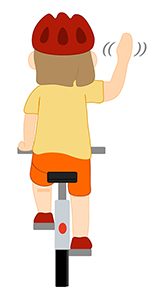
If you enjoyed Bike Brooklyn!, you may also want to check out my journal entries about biking, especially Things I've learned about biking for transportation in NYC and Some useful 311 requests regarding bike infrastructure in NYC.
-
On an e-bike, you must always yield to pedestrians per New York State Vehicle and Traffic Laws § 1242 (7). ↩
-
New York City Administrative Code § 19-195.1; warning: not all cops and judges know this rule... ↩
-
Idaho stops are not yet legal in NYC. ↩
-
NYC Traffic Rules and Regulations, Title 34, Chapter 4 § 4-12 (p) ↩
-
I am not a lawyer. This zine is not legal advice. ↩
-
Make your rides - and everyone's rides - safer and more comfortable by advocating for safe bike infrastructure! ↩
-
NYC DOT publishes the bike map annually in the spring, but new bike infrastructure pops up year round! https://www.nyc.gov/html/dot/html/bicyclists/bike- projects.shtml has details about in-progress bike projects. ↩
-
Ideally, every intersection would have safe, clear access into protected bike lanes on those streets. ↩
-
Some say the bike stamps indicate where a bicyclist can safely ride in the sharrow, but as this example from the bike map shows, that's not always the case! ↩
-
Sharrows may be more dangerous than streets without bike infrastructure. https://momentummag.com/sharrows-used-to-make-sense-in-theory-but-are-now-useless-in-practice/ ↩
-
Cobblestone streets with granite bike strips to ride on, like York St, aren't marked as cobblestone on the map. ↩
-
https://www.rei.com/learn/expert-advice/bike-fit.html is a good starting point for fitting your bikes, and many local bike shops will help you fit your bikes! ↩
-
I do know Governors Island is in Manhattan. You can take bikes on the ferry. There's bike share on the island, too! ↩
-
https://www.ferry.nyc/experience/our-boats/boarding-process ↩
-
https://www.njtransit.com/first-run/two-wheeled-adventures-welcomed ↩
-
Sadly, this lane is also occupied by whichever other cars choose to illegally enter Prospect Park since the current design doesn't stop them and there is little enforcement. ↩
-
We need a redesign of Grand Army Plaza that shifts more space from cars to people! ↩
-
One of my close friends calls paint-only bike lanes "door lanes" for this reason. ↩
-
Reminder: I am not a lawyer; this zine is not legal advice. ↩
-
If you're like me, you'll probably want to just swap for a spare tube while you're out and wait to patch the punctured one from the comfort of your own home. ↩
-
You might also save a little money on tubes this way. ↩
-
Many children's bikes and most folding bikes require tubes in sizes you can't count on most bike shops to stock. ↩
-
Many bike share bikes have worn out brakes. Check their brakes before you ride. "Wrench" bikes that need repair. ↩
-
If you're bad at charging things like I am, consider getting a dynamo lighting system on your bike so your lights are always on the bike and ready. ↩